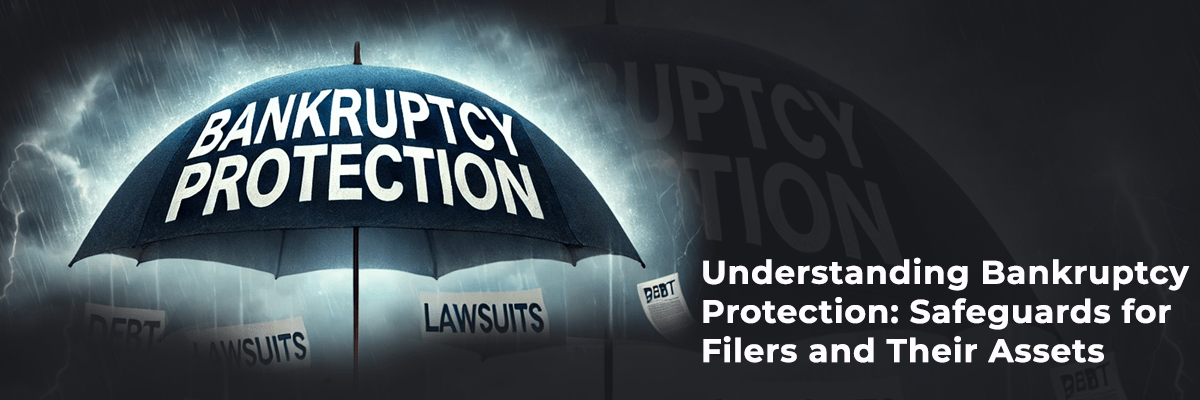Understanding Bankruptcy Protection: Safeguards for Filers and Their Assets
Filing for bankruptcy can be a daunting and emotionally challenging experience. However, the U.S. Bankruptcy Code provides essential protections designed to give debtors relief and a structured path to financial recovery. One of the most critical protections is the automatic stay, but there are other important rules and exemptions that help debtors retain assets and shield themselves from aggressive collection efforts. This article will explore the key types of bankruptcy protection available to individuals and businesses under federal law.
1. The Automatic Stay: Immediate Relief from Creditor Actions
The automatic stay is one of the most powerful and immediate protections available to bankruptcy filers. Under 11 U.S.C. § 362 of the Bankruptcy Code, the automatic stay goes into effect the moment a bankruptcy petition is filed.
What the Automatic Stay Does:
The automatic stay acts as a legal injunction that halts nearly all collection efforts, including:
Lawsuits: Creditors are prohibited from initiating or continuing lawsuits against the debtor.
Wage Garnishments: Any ongoing garnishments of wages must stop immediately.
Foreclosures and Repossessions: Creditors cannot proceed with foreclosure actions on a debtor’s home or repossess personal property, including vehicles.
Phone Calls and Harassment: Creditors must stop all communication and harassment efforts once the stay is in place.
Utility Shut-Offs: Utility providers are barred from discontinuing services due to unpaid debts.
Exceptions to the Automatic Stay:
Certain legal actions are not halted by the automatic stay, including:
- Criminal proceedings
- Certain family law matters, such as child support and alimony
- Tax audits and certain tax assessments
The automatic stay remains in place until the case is discharged or dismissed, unless lifted earlier by court order. In cases where the debtor has filed for bankruptcy multiple times within a short period, the stay may be limited or not apply at all.
2. Bankruptcy Exemptions: Protecting Your Assets
Bankruptcy law allows debtors to retain certain assets through the use of exemptions. Exemptions protect property from being liquidated to satisfy creditor claims. The types and amounts of exemptions available depend on whether the debtor files under Chapter 7 or Chapter 13 and whether state or federal exemptions are applied.
Common Federal Exemptions (Under 11 U.S.C. § 522):
Homestead Exemption: Protects equity in a primary residence (up to a specified limit).
Vehicle Exemption: Protects equity in a motor vehicle (up to a certain value).
Personal Property: Protects household goods, clothing, appliances, and other personal property up to specified limits.
Retirement Accounts: Most tax-qualified retirement accounts, including 401(k)s and IRAs, are fully exempt.
Wildcard Exemption: Allows debtors to protect any property of their choice up to a specific value.
State vs. Federal Exemptions:
Some states require debtors to use state-specific exemptions, while others allow debtors to choose between state and federal exemptions. The choice between federal and state exemptions can significantly impact the debtor’s ability to retain property.
3. Chapter-Specific Protections
Chapter 7 (Liquidation) Protections
In Chapter 7 bankruptcy, a trustee is appointed to liquidate non-exempt assets and distribute the proceeds to creditors. However, properly claimed exemptions allow debtors to retain essential property, such as their home, vehicle, and personal belongings. If all assets are protected by exemptions, the debtor may retain all property while discharging unsecured debts.
Chapter 13 (Reorganization) Protections
In Chapter 13 bankruptcy, the debtor proposes a repayment plan to reorganize debts over a period of 3 to 5 years. Unlike Chapter 7, no assets are liquidated. Instead, the debtor makes payments to creditors based on disposable income. The automatic stay protects the debtor from foreclosure, repossession, and collection efforts during the repayment period.
4. Protection from Discriminatory Treatment
Under 11 U.S.C. § 525, bankruptcy filers are protected from discrimination by governmental entities and private employers based on their bankruptcy filing. For example, a government agency cannot deny a license, permit, or public benefit solely because the applicant filed for bankruptcy. Similarly, employers cannot terminate or refuse to hire an individual based on a bankruptcy filing.
5. Reaffirmation and Redemption of Secured Debts
Debtors have additional protections when dealing with secured debts:
Reaffirmation Agreements: Debtors may voluntarily agree to continue paying secured debts, such as car loans, to retain the collateral.
Redemption: Under 11 U.S.C. § 722, debtors can redeem secured property by paying the creditor the current market value of the collateral in a lump sum, even if the loan balance exceeds the asset’s value.
6. Discharge Protections
Upon successful completion of a bankruptcy case, debtors receive a discharge order under 11 U.S.C. § 524, which legally eliminates their personal liability for most unsecured debts. Creditors are permanently prohibited from attempting to collect on discharged debts.
In Chapter 7, discharge typically occurs within a few months.
In Chapter 13, discharge is granted after completion of the repayment plan.
Certain debts, such as student loans, child support, and certain tax obligations, are generally non-dischargeable unless the debtor meets specific hardship criteria.
Conclusion
Bankruptcy protection is designed to give debtors a fresh start while balancing the rights of creditors. The automatic stay, exemption rules, and discharge protections work together to provide immediate relief and long-term financial stability. For those considering bankruptcy, understanding these protections and working with an experienced bankruptcy attorney can help maximize the benefits of the bankruptcy process and ensure a successful financial recovery.


